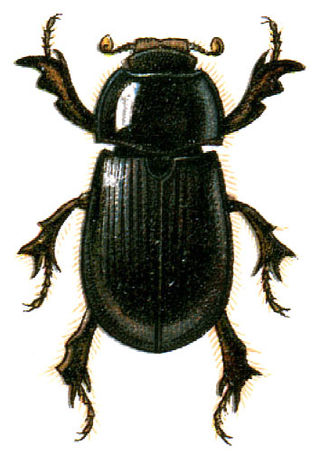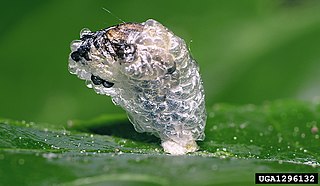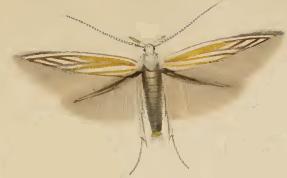
Plankton are the diverse collection of organisms found in water that are unable to propel themselves against a current. The individual organisms constituting plankton are called plankters. In the ocean, they provide a crucial source of food to many small and large aquatic organisms, such as bivalves, fish, and baleen whales.

Caterpillars are the larval stage of members of the order Lepidoptera.

Herring are forage fish, mostly belonging to the family of Clupeidae.

A larva is a distinct juvenile form many animals undergo before metamorphosis into adults. Animals with indirect development such as insects, amphibians, or cnidarians typically have a larval phase of their life cycle.

Hover flies, also called flower flies or syrphid flies, make up the insect family Syrphidae. As their common name suggests, they are often seen hovering or nectaring at flowers; the adults of many species feed mainly on nectar and pollen, while the larvae (maggots) eat a wide range of foods. In some species, the larvae are saprotrophs, eating decaying plant and animal matter in the soil or in ponds and streams. In other species, the larvae are insectivores and prey on aphids, thrips, and other plant-sucking insects.

A crane fly is any member of the insect superfamily Tipuloidea, which contains the living families Cylindrotomidae, Limoniidae, Pediciidae and Tipulidae, and the extinct family Architipulidae. "Winter crane flies", members of the family Trichoceridae, are sufficiently different from the typical crane flies of Tipuloidea to be excluded from the superfamily Tipuloidea.

Mealworms are the larval form of the yellow mealworm beetle, Tenebrio molitor, a species of darkling beetle. Like all holometabolic insects, they go through four life stages: egg, larva, pupa, and adult. Larvae typically measure about 2.5 centimetres (0.98 in) or more, whereas adults are generally 1.25 to 1.8 centimetres in length.

Hybosoridae, sometimes known as the scavenger scarab beetles, is a family of scarabaeiform beetles. The 690 species in 97 genera occur widely in the tropics, but little is known of their biology.

Ancylostoma braziliense is a species of hookworm belonging to the genus Ancylostoma. It is an intestinal parasite of domestic cats and dogs. Severe infection is often fatal to these pets, especially in puppies and kittens. The infection is particularly endemic in the southern United States. It is most often confused with the zoonotic hookworm species Ancylostoma ceylanicum because of their uncanny resemblance.
Atralata is a genus of moths of the family Crambidae. It contains only one species, Atralata albofascialis, which is found in most of Europe, except Ireland, Great Britain, Norway, Finland, Lithuania and Greece.

Coleophora kuehnella is a moth of the family Coleophoridae. It was first described by Johann Goeze in 1783 and is found in Asia and Europe.

Laemophloeidae, "lined flat bark beetles," is a family in the superfamily Cucujoidea characterized by predominantly dorso-ventrally compressed bodies, head and pronotal discs bordered by ridges or grooves, and inverted male genitalia. Size range of adults is 1–5 mm (0.04–0.2 in) in length. Currently, it contains 40 genera and about 450 species, and is represented on all continents except Antarctica; species richness is greatest in the tropics.

Coleophora currucipennella is a moth of the family Coleophoridae found in Europe. It was first described by Philipp Christoph Zeller in 1839.

Adscita geryon, the cistus forester, is a moth of the family Zygaenidae. It is found in southern and central Europe, east to Turkey. It is also present in Great Britain.
Acrolepiopsis vesperella is a moth of the family Acrolepiidae. It is found in Germany, France, Spain, Portugal, Italy, Croatia, Serbia and Montenegro, Greece and on the Canary Islands.

Digitivalva arnicella is a moth of the family Acrolepiidae. It is found in Norway, Sweden, the Netherlands, Belgium, Denmark, Germany, France, Switzerland, Austria, Italy, Hungary, Slovakia, the Czech Republic, Romania, Poland and Lithuania.
Digitivalva perlepidella is a moth of the family Acrolepiidae. It is found in Great Britain, the Netherlands, France, Germany, Switzerland, Austria, Poland, the Czech Republic, Slovakia, Hungary, Croatia, Romania and Bulgaria.

Digitivalva reticulella is a moth of the family Acrolepiidae found in most of Europe, except Ireland, Great Britain, the Netherlands, France, Portugal, Slovenia, much of the Balkan Peninsula, and Lithuania.

Digitivalva pulicariae is a moth of the family Acrolepiidae. It is found in most of Europe, except Portugal, Fennoscandia, the Baltic region and Poland.

Ochsenheimeria vacculella, the cereal stem moth, is a moth of the family Ypsolophidae. It is found in most of Europe, except Ireland, Norway, Portugal, Italy and most of the Balkan Peninsula. The species was accidentally introduced into parts of the United States.















